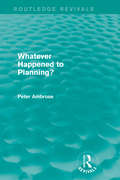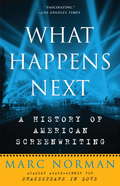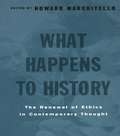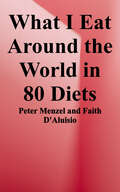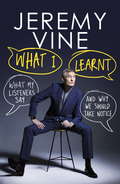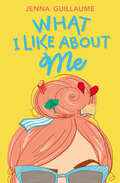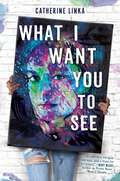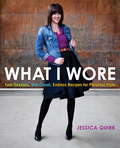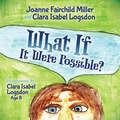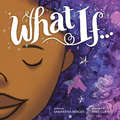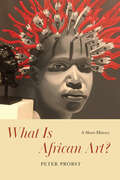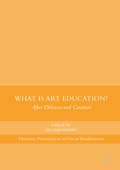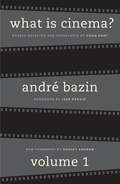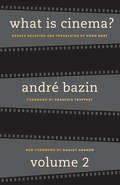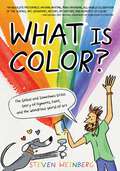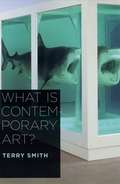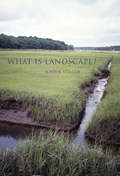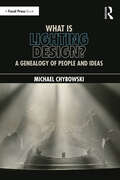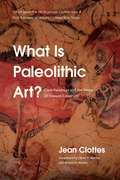- Table View
- List View
What Happened to Planning? (Routledge Revivals)
by Peter AmbroseThis title was first published in 1986 during a recession much like that faced in recent years, which placed immense pressure on the British planning system and led to social unrest in the inner cities and in many disadvantaged areas. Within this context, Peter Ambrose outlines the features of land development and explores the circumstances of post-war planning. The central section of the book deals with the key forces at work in land development – finance, the construction industry and the local and central state – and explains how they interact. Using a number of case-studies, including the greenfield urban fringe and London’s docklands, as well as examples drawn from other countries, Ambrose provides an essential background to the British planning system and the problems still faced by it today.
What Happens Next: A History of American Screenwriting
by Marc NormanShakespeare in Love screenwriter Norman offers a history of his Hollywood predecessors and contemporaries, the famously despised screenwriters. Stories include the fallout of the McCarthy-era blacklists, the introduction of the Production Code and writers' attempts to outsmart the censors, the disappointment of director Billy Wilder upon hiring master crime novelist Raymond Chandler to script Double Indemnity (later nominated for a Best Screenplay Oscar), and the redefining of screenwriting by the likes of Quentin Tarantino and Charlie Kaufman. Annotation ©2008 Book News, Inc. , Portland, OR (booknews. com)
What Happens to History: The Renewal of Ethics in COntemporary Thought
by Howard MarchitelloWhile the questions of ethics have become increasingly important in recent years for many fields within the humanities, there has been no single volume that seeks to address the emergence of this concern with ethics across the disciplinary spectrum. Given this lack in currently available critical and secondary texts, and also the urgency of the issues addressed by the critics assembled here, the time is right for a collection of this nature.
What Have We Here?: Portraits of a Life
by Billy Dee WilliamsA film legend recalls his remarkable life of nearly eight decades—a heralded actor who's played the roles he wanted, from Brian’s Song to Lando in the Star Wars universe—unchecked by the racism and typecasting so rife in the mostly all-white industry in which he triumphed. <p><p> Billy Dee Williams was born in Harlem in 1937 and grew up in a household of love and sophistication. As a young boy, he made his stage debut working with Lotte Lenya in an Ira Gershwin/Kurt Weill production where Williams ended up feeding Lenya her lines. He studied painting, first at the High School of Music and Art, with fellow student Diahann Carroll, and then at the National Academy of Fine Art, before setting out to pursue acting with Herbert Berghoff, Stella Adler, and Sidney Poitier. <p><p> His first film role was in The Last Angry Man, the great Paul Muni’s final film. It was Muni who gave Billy the advice that sent him soaring as an actor, “You can play any character you want to play no matter who you are, no matter the way you look or the color of your skin.” And Williams writes, “I wanted to be anyone I wanted to be.” <p><p> He writes of landing the role of a lifetime: co-starring alongside James Caan in Brian’s Song, the made-for-television movie that was watched by an audience of more than fifty million people. Williams says it was “the kind of interracial love story America needed.” <p><p> And when, as the first Black character in the Star Wars universe, he became a true pop culture icon, playing Lando Calrissian in George Lucas’s The Empire Strikes Back (“What I presented on the screen people didn’t expect to see”). It was a role he reprised in the final film of the original trilogy, The Return of the Jedi, and in the recent sequel The Rise of Skywalker. <p><p> A legendary actor, in his own words, on all that has sustained and carried him through a lifetime of dreams and adventure. <p> <b>New York Times Bestseller</b>
What I Eat: Around the World in 80 Diets
by Faith D'AluisioA stunning photographic collection featuring portraits of 80 people from 30 countries and the food they eat in one day. In this fascinating study of people and their diets, 80 profiles are organized by the total number of calories each person puts away in a day. <p><p>Featuring a Japanese sumo wrestler, a Massai herdswoman, world-renowned Spanish chef Ferran Adria, an American competitive eater, and more, these compulsively readable personal stories also include demographic particulars, including age, activity level, height, and weight. <p><p>Essays from Harvard primatologist Richard Wrangham, journalist Michael Pollan, and others discuss the implications of our modern diets for our health and for the planet. This compelling blend of photography and investigative reportage expands our understanding of the complex relationships among individuals, culture, and food.
What I Learnt: What My Listeners Say and Why We Should Hear Them
by Jeremy VineJeremy Vine has been presenting a BBC Radio 2 show since 2003 that attracts more than seven million listeners. In that time he calculates he has taken more than 25,000 calls on topical subjects - big issues and small ones: on life, love, lollipop ladies and poisonous plants. But what have the callers told him? In the age of Brexit and Donald Trump, is the world now being run by Radio 2 listeners? If you listen to Radio 4, Brexit was a shock. If you are a Radio 2 listener it wouldn't have surprised you at all. Where Jeremy's callers once expressed a kind of resignation ('But what can you do?' or the gloomy rejoinder: 'You have to laugh'), now they tend to give him their views expecting to be heeded. They have not called in to entertain the audience. They expect to take the wheel of the car and drive.Listener wisdom is far more valuable than most of what we hear from appointed spokespeople. What was the response when Jeremy asked: 'Have you ever been pecked in the eye by a gannet?' Which subjects are most likely to start pitched warfare between different sections of the audience? (Answer: old people using buses, old people NOT using buses, cellophane, or Tony Blair saying anything.)In a book punctuated by vivid anecdotes and laugh-out-loud moments, Jeremy Vine explains what it's like to hit a button and hear - totally unvarnished and unspun - the voices of so-called ordinary people. And why they are not so ordinary after all.
What I Like About Me
by Jenna GuillaumePlus-sized sixteen-year-old Maisie Martin never thought she had the figure to compete in a beauty pageant, but this vacation is about to change everything.Maisie has spent most of her life hiding her body from everyone: her gorgeous best friend, her pageant-winning sister, and definitely her longtime crush. Never one to jump in the water, Maisie is planning on taking it easy while her friends chill at the beach.But then her BFF starts flirting with the boy she's always loved, her older sister comes home and steals the spotlight, and Maisie has found herself pushed aside like usual. Except now, she's had enough. After forging new friendships, Maisie takes the deep dive and enters the local Miss Teen Queen. Now, with all eyes on her, can Maisie prove she has a place in the spotlight?This contemporary young adult novel is as relatable as it is charming and Maisie's realistic journey towards confidence and self-love will draw readers in as she learns how to celebrate all of herself.
What I Want You to See
by Catherine LinkaA college freshman is swept into shaky moral territory within the cut-throat world of visual arts in this razor-sharp novel.Winning a scholarship to California's most prestigious art school seems like a fairy tale ending to Sabine Reye's awful senior year. After losing both her mother and her home, Sabine longs for a place where she belongs. But the cutthroat world of visual arts is nothing like what Sabine had imagined. Colin Krell, the renowned faculty member whom she had hoped would mentor her, seems to take merciless delight in tearing down her best work -- and warns her that she'll lose the merit-based award if she doesn't improve. Desperate and humiliated, Sabine doesn't know where to turn. Then she meets Adam, a grad student who understands better than anyone the pressures of art school. He even helps Sabine get insight on Krell by showing her the modern master's work in progress, a portrait that's sold for a million dollars sight unseen. Sabine is enthralled by the portrait; within those swirling, colorful layers of paint is the key to winning her inscrutable teacher's approval. Krell did advise her to improve her craft by copying a painting she connects with...but what would he think of Sabine secretly painting her own version of his masterpiece? And what should she do when she accidentally becomes party to a crime so well-plotted that no one knows about it but her? Complex and utterly original, What I Want You to See is a gripping tale of deception, attraction, and moral ambiguity.
What I Wore
by Jessica QuirkA COOKBOOK FOR YOUR CLOSET Personal style expert Jessica Quirk approaches getting dressed just as you would plan the perfect meal: With a smartly stocked pantry and a few gorgeous "spotlight ingredients," inspiration comes easily.In What I Wore, named after her enormously popular blog, Jessica shares recipes for creating a stellar wardrobe to get you through spring, summer, fall, and winter. From delicates (bras, slips, lingerie) to the basics every woman should have (black pants, white shirts, knee-high leather boots) to the dramatic touches that set just the right tone (scarves, jewelry, handbags), she shows you how to take your look from ordinary to outstanding without breaking the bank. Inside you'll discover how to * remix the clothing you already have for dozens of fresh, pulled-together looks* become a smarter shopper and always get the most bang for your buck* create wow-worthy ensembles for special occasions, weekends, and the office* supplement basics and investment pieces with fun and inexpensive accessories Plus you'll learn tailoring tricks, handy hints, and packing tips to ensure that you always leave the house looking your best. Loaded with hundreds of vibrant, original illustrations and unique suggestions for combining colors, patterns, and textures, What I Wore will help you feel stylish and confident, each and every day.From the Trade Paperback edition.
What If It Were Possible?
by Joanne Fairchild Miller Clara Isabel LogsdonThe author and her eight-year-old granddaughter, Clara, explore the world of their imaginations in this unique children&’s book illustrated by Clara. What if it were possible . . . for a dog to climb a tree? What if it were possible to climb like you and me? What if pretty butterflies could spread their wings and swim? And elephants could wear their trunks while working out at gyms? Anything can happen if you think it might. In your imagination, ANYTHING is RIGHT! Eight-year-old Clara has a vivid imagination. One day while visiting her Yia-Yia, author Joanne Miller, they watched Clara&’s dog, Harley, desperately try to climb a tree to get a squirrel. Then Joanne asked Clara a provocative question: &“What if it were possible for a dog to climb a tree?&” And the rest is history. Joanne and Clara had lots of giggles coming up with crazy lines for this book, and Clara drew each illustration with water color pencils. Clara and her Yia Yia don&’t believe play and imagination are only for children. In What If It Were Possible? they demonstrate the limitless wonders we can discover in our minds.
What If...
by Samantha Berger Mike CuratoCreativity, the power of imagination, and the importance of self-expression are celebrated in this inspiring picture book written and illustrated by real-life best friends.This girl is determined to express herself! If she can't draw her dreams, she'll sculpt or build, carve or collage. If she can't do that, she'll turn her world into a canvas. And if everything around her is taken away, she'll sing, dance, and dream...Stunning mixed media illustrations, lyrical text, and a breathtaking gatefold conjure powerful magic in this heartfelt affirmation of art, imagination, and the resilience of the human spirit.
What If?: Twenty-Two Scenarios in Search of Images
by Vilém FlusserAn imagination of possibilities, of miscalculations, of futures off-kilter &“Probability is a chimera, its head is true, its tail a suggestion. Futurologists attempt to compel the head to eat the tail (ouroboros). Here, though, we will try to wag the tail.&” —Vilém Flusser Two years after his Vampyroteuthis Infernalis, the philosopher Vilém Flusser engaged in another thought experiment: a collection of twenty-two &“scenarios for the future&” to be produced as computer-generated media, or technical images, that would break the imaginative logjam in conceiving the social, political, and economic future of the universe. What If? is not just an &“impossible journey&” to which Flusser invites us in the first scenario; it functions also as a distorting mirror held up to humanity. Flusser&’s disarming scenarios of an Anthropocene fraught with nightmares offer new visions that range from the scientific to the fantastic to the playful and whimsical. Each essay reflects our present sense of understanding the world, considering the exploitation of nature and the dangers of global warming, overpopulation, and blind reliance on the promises of scientific knowledge and invention. What If? offers insight into the radical futures of a slipstream Anthropocene that have much to do with speculative fiction, with Flusser&’s concept of design as &“crafty&” or slippery, and with art and the immense creative potential of failure versus reasonable, &“good&” computing or calculability. As such, the book is both a warning and a nudge to imagine what we may yet become and be.
What Is African Art?: A Short History
by Peter ProbstA history of the evolving field of African art. This book examines the invention and development of African art as an art historical category. It starts with a simple question: What do we mean when we talk about African art? By confronting the historically shifting answers to this question, Peter Probst identifies “African art” as a conceptual vessel that manifests wider societal transformations. What Is African Art? covers three key stages in the field’s history. Starting with the late nineteenth through the mid-twentieth centuries, the book first discusses the colonial formation of the field by focusing on the role of museums, collectors, and photography in disseminating visual cultures as relations of power. It then explores the remaking of the field at the dawn of African independence with the shift toward contemporary art and the rise of Black Atlantic studies in the 1970s and 1980s. Finally, it examines the post- and decolonial reconfiguration of the field driven by questions of representation, repair, and restitution.
What Is African Art?: A Short History
by Peter ProbstA history of the evolving field of African art. This book examines the invention and development of African art as an art historical category. It starts with a simple question: What do we mean when we talk about African art? By confronting the historically shifting answers to this question, Peter Probst identifies “African art” as a conceptual vessel that manifests wider societal transformations. What Is African Art? covers three key stages in the field’s history. Starting with the late nineteenth through the mid-twentieth centuries, the book first discusses the colonial formation of the field by focusing on the role of museums, collectors, and photography in disseminating visual cultures as relations of power. It then explores the remaking of the field at the dawn of African independence with the shift toward contemporary art and the rise of Black Atlantic studies in the 1970s and 1980s. Finally, it examines the post- and decolonial reconfiguration of the field driven by questions of representation, repair, and restitution.
What Is African Art?: A Short History
by Peter ProbstA history of the evolving field of African art. This book examines the invention and development of African art as an art historical category. It starts with a simple question: What do we mean when we talk about African art? By confronting the historically shifting answers to this question, Peter Probst identifies “African art” as a conceptual vessel that manifests wider societal transformations. What Is African Art? covers three key stages in the field’s history. Starting with the late nineteenth through the mid-twentieth centuries, the book first discusses the colonial formation of the field by focusing on the role of museums, collectors, and photography in disseminating visual cultures as relations of power. It then explores the remaking of the field at the dawn of African independence with the shift toward contemporary art and the rise of Black Atlantic studies in the 1970s and 1980s. Finally, it examines the post- and decolonial reconfiguration of the field driven by questions of representation, repair, and restitution.
What Is Art Education?: After Deleuze and Guattari (Education, Psychoanalysis, and Social Transformation)
by Jan JagodzinskiThis edited book gathers seven established art educators-educator artists who address art education from the philosophical position of Deleuze and Guattari. This book raises questions as to where the future of art and its education might be heading if the focus on art was to be repositioned along Deleuze and Guattari’s philosophy of immanence. The chapters are speculative as they query what is ‘thinking’ in the art process. There is an attempt to project other forms of what art can ‘do,’ and the curriculum that can emerge when a student-centered problematic is explored along such lines.
What Is Cinema?
by Hugh Gray Dudley Andrew André Bazin Jean RenoirAndré Bazin's What Is Cinema? (volumes I and II) have been classics of film studies for as long as they've been available and are considered the gold standard in the field of film criticism. Although Bazin made no films, his name has been one of the most important in French cinema since World War II. He was co-founder of the influential Cahiers du Cinéma, which under his leadership became one of the world's most distinguished publications. Championing the films of Jean Renoir (who contributed a short foreword to Volume I), Orson Welles, and Roberto Rossellini, he became the protégé of François Truffaut, who honors him touchingly in his forword to Volume II. This new edition includes graceful forewords to each volume by Bazin scholar and biographer Dudley Andrew, who reconsiders Bazin and his place in contemporary film study. The essays themselves are erudite but always accessible, intellectual, and stimulating. As Renoir puts it, the essays of Bazin "will survive even if the cinema does not."
What Is Cinema?
by Hugh Gray Dudley Andrew André Bazin Francois TruffautAndré Bazin's What Is Cinema? (volumes I and II) have been classics of film studies for as long as they've been available and are considered the gold standard in the field of film criticism. Although Bazin made no films, his name has been one of the most important in French cinema since World War II. He was co-founder of the influential Cahiers du Cinéma, which under his leadership became one of the world's most distinguished publications. Championing the films of Jean Renoir (who contributed a short foreword to Volume I), Orson Welles, and Roberto Rossellini, he became the protégé of François Truffaut, who honors him touchingly in his forword to Volume II. This new edition includes graceful forewords to each volume by Bazin scholar and biographer Dudley Andrew, who reconsiders Bazin and his place in contemporary film study. The essays themselves are erudite but always accessible, intellectual, and stimulating. As Renoir puts it, the essays of Bazin "will survive even if the cinema does not."
What Is Color?: The Global and Sometimes Gross Story of Pigments, Paint, and the Wondrous World of Art
by Steven WeinbergIn this zany and vibrantly illustrated nonfiction guide to all things color, the origins of today's pigments come alive across continents and history, with oodles of art, tons of science--and extensive interactive backmatter!So what is color? A red apple? A yellow banana? The purple goo from a squished sea snail?Once you start digging, color turns out to be a lot of things--it’s messy, stinky, and even a little bit dangerous. You may already know that it’s art, but it’s science, too! What Is Color? will take readers all over the world, introducing them to talented, brilliant, creative people from scientists to famous artists and everyone in between as we take the color wheel for a spin.Perfect for curious and creative minds who love paintbrushes as much as microscopes, this clever and eye-catching full-color nonfiction book dives deep into the strange, wacky, silly, and occasionally perilous history behind the colors that paint our everyday lives.Readers will get:• A laugh-out-loud funny adventure full of gross-out facts (like how cow pee can be used to make the color yellow!).• Hilarious illustrations that encourage creativity and fun while learning!• A kid-friendly primer on global art history, from Yayoi Kusama to Van Gogh, Basquiat, and many more.• A dazzling full-color book, with rainbow edges and vibrant info-filled endpapers.• Extensive backmatter with a glossary plus art and science activities perfect for the classroom and home!
What Is Contemporary Art?
by Terry SmithWho gets to say what counts as contemporary art? Artists, critics, curators, gallerists, auctioneers, collectors, or the public? Revealing how all these groups have shaped today's multifaceted definition, Terry Smith brilliantly shows that a historical approach offers the best answer to the question: What Is Contemporary Art?
What Is Cosmopolitical Design? Design, Nature and the Built Environment: Design, Nature And The Built Environment
by Albena Yaneva Alejandro Zaera-PoloThe scale of ecological crises made us realize that every kind of politics has always been cosmopolitics, politics of a cosmos. Cosmos embraces everything, including the multifarious natural and material entities that make humans act. The book examines cosmopolitics in its relation to design practice. Abandoning the modernist idea of nature as being external to the human experience - a nature that can be mastered by engineers and scientists from outside, the cosmpolitical thinking offers designers to embark in an active process of manipulating and reworking nature ’from within.’ To engage in cosmopolitics, this book argues, means to redesign, create, instigate, and compose every single feature of our common experience. In the light of this new understanding of nature, we set the questions: What is the role of design if nature is no longer salient enough to provide a background for human activities? How can we foster designers’ own force and make present what causes designers to think, feel, and act? How do designers make explicit the connection of humans to a variety of entities with different ontology: rivers, species, particles, materials and forces? How do they redefine political order by bringing together stars, prions and people? In effect, how should we understand design practice in its relation to the material and the living world? In this volume, anthropologists, science studies scholars, political scientists and sociologists rethink together the meaning of cosmopolitics for design. At the same time designers, architects and artists engage with the cosmopolitical question in trying to imagine the future of architectural and urban design. The book contains original empirical chapters and a number of revealing interviews with artists and designers whose practices set examples of ’cosmopolitically correct design’.
What Is Japanese Cinema?: A History
by Yomota InuhikoWhat might Godzilla and Kurosawa have in common? What, if anything, links Ozu’s sparse portraits of domestic life and the colorful worlds of anime? In What Is Japanese Cinema? Yomota Inuhiko provides a concise and lively history of Japanese film that shows how cinema tells the story of Japan’s modern age.Discussing popular works alongside auteurist masterpieces, Yomota considers films in light of both Japanese cultural particularities and cinema as a worldwide art form. He covers the history of Japanese film from the silent era to the rise of J-Horror in its historical, technological, and global contexts. Yomota shows how Japanese film has been shaped by traditonal art forms such as kabuki theater as well as foreign influences spanning Hollywood and Italian neorealism. Along the way, he considers the first golden age of Japanese film; colonial filmmaking in Korea, Manchuria, and Taiwan; the impact of World War II and the U.S. occupation; the Japanese film industry’s rise to international prominence during the 1950s and 1960s; and the challenges and technological shifts of recent decades. Alongside a larger thematic discussion of what defines and characterizes Japanese film, Yomota provides insightful readings of canonical directors including Kurosawa, Ozu, Suzuki, and Miyazaki as well as genre movies, documentaries, indie film, and pornography. An incisive and opinionated history, What Is Japanese Cinema? is essential reading for admirers and students of Japan’s contributions to the world of film.
What Is Landscape?
by John R. StilgoeA lexicon and guide for discovering the essence of landscape.“Mr. Stilgoe does not ask that we take his book outdoors with us; he believes that reading and experiencing landscapes are activities that should be kept separate. But, as I learned in his book, the hollow storage area in a car driver's door was once a holster, the 'secure nesting place of a pistol.' I recommend you stow your copy there.”—The Wall Street JournalLandscape, John Stilgoe tells us, is a noun. From the old Frisian language (once spoken in coastal parts of the Netherlands and Germany), it meant shoveled land: landschop. Sixteenth-century Englishmen misheard or mispronounced this as landskep, which became landskip, then landscape, designating the surface of the earth shaped for human habitation. In What Is Landscape? Stilgoe maps the discovery of landscape by putting words to things, zeroing in on landscape's essence but also leading sideways expeditions through such sources as children's picture books, folklore, deeds, antique terminology, out-of-print dictionaries, and conversations with locals. (“What is that?” “Well, it's not really a slough, not really, it's a bayou...”) He offers a highly original, cogent, compact, gracefully written narrative lexicon of landscape as word, concept, and path to discoveries.What Is Landscape? is an invitation to walk, to notice, to ask: to see a sandcastle with a pinwheel at the beach and think of Dutch windmills—icons of triumph, markers of territory won from the sea; to walk in the woods and be amused by the Elizabethans' misuse of the Latin silvaticus (people of the woods) to coin the word savages; to see in a suburban front lawn a representation of the meadow of a medieval freehold.Discovering landscape is good exercise for body and for mind. This book is an essential guide and companion to that exercise—to understanding, literally and figuratively, what landscape is.
What Is Lighting Design?: A Genealogy of People and Ideas
by Michael ChybowskiWhat Is Lighting Design?: A Genealogy of People and Ideas explains what lighting design is by looking at the history of ideas that are a part of this craft and how those ideas developed. Lighting design began in the West with the Renaissance, and each historical period since then has modified how and why light is used in performance, the methods for producing light, and the consensus around what its purpose is. Exploring each lighting design era and the basic components of lighting design, the book discusses how the central ideas of this craft developed over the past 500 years, what today’s lighting designers are concerned with, and how lighting design contributes to performances. This book is designed as a main course text for History of Lighting Design university courses and a supplementary text for and Introduction to Lighting Design, Stagecraft, and Scenography courses. It will also be of interest to directors, choreographers, and working lighting designers who wish to explore the history and meaning of their craft.
What Is Paleolithic Art?: Cave Paintings and the Dawn of Human Creativity
by Jean Clottes Oliver Y. Martin Robert D. MartinWas it a trick of the light that drew our Stone Age ancestors into caves to paint in charcoal and red hematite, to watch the heads of lions, likenesses of bison, horses, and aurochs in the reliefs of the walls, as they flickered by firelight? Or was it something deeper--a creative impulse, a spiritual dawn, a shamanistic conception of the world efflorescing in the dark, dank spaces beneath the surface of the earth where the spirits were literally at hand? In this book, Jean Clottes, one of the most renowned figures in the study of cave paintings, pursues an answer to this "why" of Paleolithic art. While other books focus on particular sites and surveys, Clottes's work is a contemplative journey across the world, a personal reflection on how we have viewed these paintings in the past, what we learn from looking at them across geographies, and what these paintings may have meant--what function they may have served--for their artists. Steeped in Clottes's shamanistic theories of cave painting, What Is Paleolithic Art? travels from well-known Ice Age sites like Chauvet, Altamira, and Lascaux to visits with contemporary aboriginal artists, evoking a continuum between the cave paintings of our prehistoric past and the living rock art of today. Clottes's work lifts us from the darkness of our Paleolithic origins to reveal, by firelight, how we think, why we create, why we believe, and who we are.
